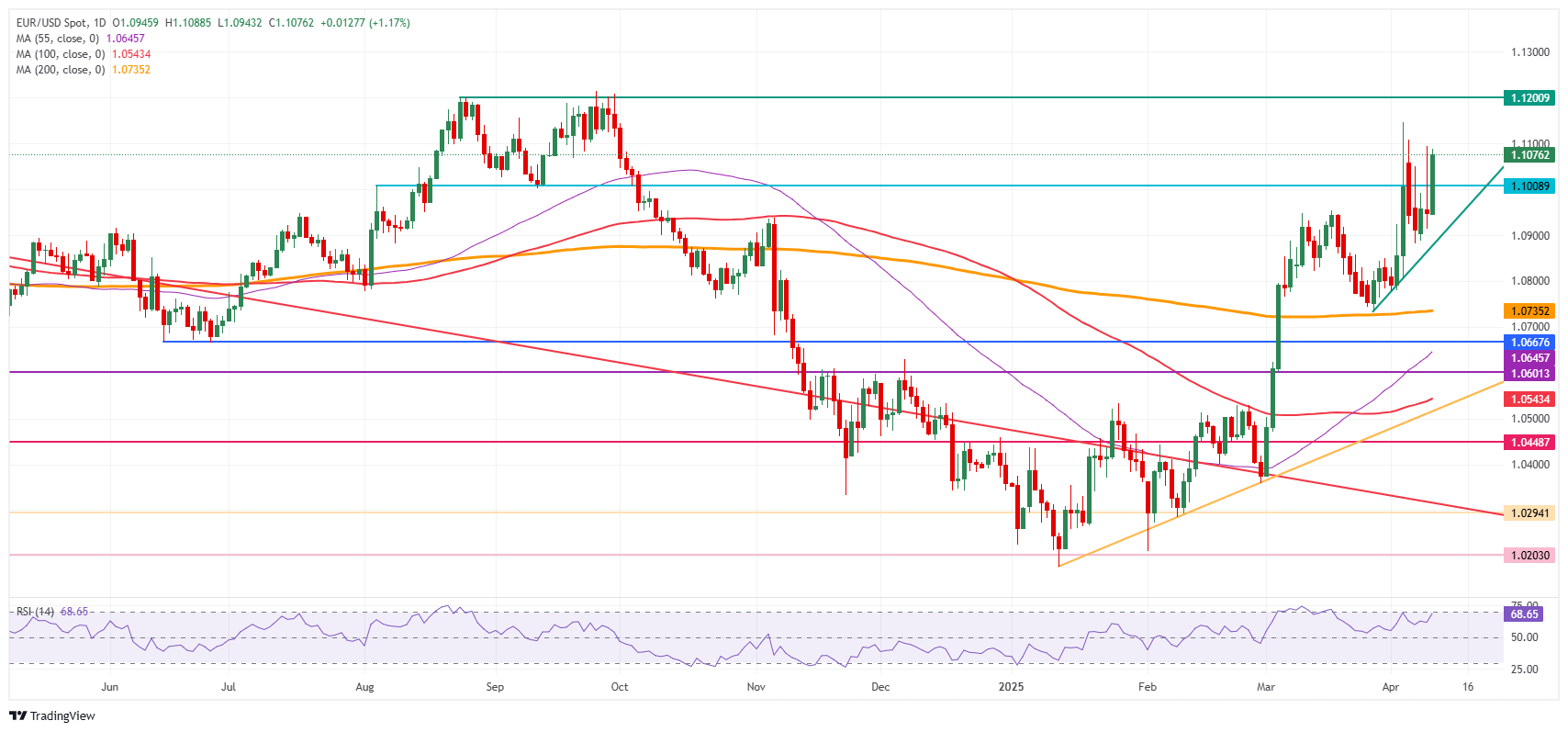Created
: 2025.04.10














![]() 2025.04.10 20:31
2025.04.10 20:31
The EUR/USD pair edges higher and recovers to 1.1050 at the time of writing on Thursday. A whipsaw session on Wednesday saw EUR/USD ranging from 1.1095 all the way down to 1.0913 as United States (US) President Donald Trump eased off his tariffs stance and lowered the reciprocal tariff rate for all countries to 10% during a 90-day pause.
The move came after several people, such as Elon Musk, Bill Ackman and some leading republican party figures - US Stock markets were also giving signs of warning - advised the US president that the reciprocal levies approach was hitting nerves. The 90-day pause was applauded by markets as US Equities went through the roof. The focus this Thursday will shift to the US Consumer Price Index (CPI) for March.
The EUR/USD pair is clearly facing volatility since Trump went ahead with his reciprocal tariffs announcement and implementation. The 90-day pause announced on Wednesday was briefly seen as a reason to strengthen the Greenback, but now market sentiment turns around the fact that 90 days might not be that much time to negotiate with all the countries hit by reciprocal tariffs on all kinds of products and goods.
The 1.1000 important psychological level is being reclaimed, with the EUR/USD nearing the 1.1050 area at the time of writing. The next target is the 1.1200 level, which limited the EUR/USD advance in August and September 2024, with interim resistance at the current year-to-date high of 1.1146.
On the downside, the ascending trend line, coming in around 1.0910, should do the trick to support the rally. In case this line is broken, the 200-day Simple Moving Average (SMA) at 1.0735 could limit the downside. Below there, the 1.0667 pivotal level and the 55-day SMA at 1.0645 should be able to support the major currency pair.

EUR/USD: Weekly Chart
The US Dollar (USD) is the official currency of the United States of America, and the 'de facto' currency of a significant number of other countries where it is found in circulation alongside local notes. It is the most heavily traded currency in the world, accounting for over 88% of all global foreign exchange turnover, or an average of $6.6 trillion in transactions per day, according to data from 2022. Following the second world war, the USD took over from the British Pound as the world's reserve currency. For most of its history, the US Dollar was backed by Gold, until the Bretton Woods Agreement in 1971 when the Gold Standard went away.
The most important single factor impacting on the value of the US Dollar is monetary policy, which is shaped by the Federal Reserve (Fed). The Fed has two mandates: to achieve price stability (control inflation) and foster full employment. Its primary tool to achieve these two goals is by adjusting interest rates. When prices are rising too quickly and inflation is above the Fed's 2% target, the Fed will raise rates, which helps the USD value. When inflation falls below 2% or the Unemployment Rate is too high, the Fed may lower interest rates, which weighs on the Greenback.
In extreme situations, the Federal Reserve can also print more Dollars and enact quantitative easing (QE). QE is the process by which the Fed substantially increases the flow of credit in a stuck financial system. It is a non-standard policy measure used when credit has dried up because banks will not lend to each other (out of the fear of counterparty default). It is a last resort when simply lowering interest rates is unlikely to achieve the necessary result. It was the Fed's weapon of choice to combat the credit crunch that occurred during the Great Financial Crisis in 2008. It involves the Fed printing more Dollars and using them to buy US government bonds predominantly from financial institutions. QE usually leads to a weaker US Dollar.
Quantitative tightening (QT) is the reverse process whereby the Federal Reserve stops buying bonds from financial institutions and does not reinvest the principal from the bonds it holds maturing in new purchases. It is usually positive for the US Dollar.
![]()
Created
: 2025.04.10
![]()
Last updated
: 2025.04.10

FXStreet is a forex information website, delivering market analysis and news articles 24/7.
It features a number of articles contributed by well-known analysts, in addition to the ones by its editorial team.
Founded in 2000 by Francesc Riverola, a Spanish economist, it has grown to become a world-renowned information website.
We hope you find this article useful. Any comments or suggestions will be greatly appreciated.
We are also looking for writers with extensive experience in forex and crypto to join us.
please contact us at [email protected].
Disclaimer:
All information and content provided on this website is provided for informational purposes only and is not intended to solicit any investment. Although all efforts are made in order to ensure that the information is correct, no guarantee is provided for the accuracy of any content on this website. Any decision made shall be the responsibility of the investor and Myforex does not take any responsibility whatsoever regarding the use of any information provided herein.
The content provided on this website belongs to Myforex and, where stated, the relevant licensors. All rights are reserved by Myforex and the relevant licensors, and no content of this website, whether in full or in part, shall be copied or displayed elsewhere without the explicit written permission of the relevant copyright holder. If you wish to use any part of the content provided on this website, please ensure that you contact Myforex.
Myforex uses cookies to improve the convenience and functionality of this website. This website may include cookies not only by us but also by third parties (advertisers, log analysts, etc.) for the purpose of tracking the activities of users. Cookie policy